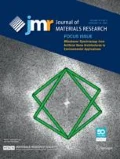Abstract
In ductile metals, sliding contact induces plastic deformation resulting in subsurfaces, the mechanical properties of which are different from those of the bulk. This article describes a novel combination of nanomechanical test methods and analysis techniques to evaluate the mechanical behavior of the subsurfaces generated underneath a wear surface. In this methodology, nanoscratch techniques were first used to generate wear patterns as a function of load and number of cycles using a Hysitron TriboIndenter. Measurements were made on a (001) single crystal plane along two crystallographic directions, <001> and <011>. Nanoindentation was then used to measure mechanical properties in each wear pattern. The results on the (001) single crystal nickel plane showed that there was a strong increase in hardness with increasing applied load that was accompanied by a change in surface deformation. The amount of deformation underneath the wear patterns was examined from focused ion beam cross-sections of the wear patterns.
Similar content being viewed by others
References
P. Heilmann, W.A.T. Clark, and D.A. Rigney: Orientation determination of subsurface cells generated by sliding. Acta Metall. 31, 1293 (1983).
S.V. Prasad, J.K. Michael, and T.R. Christenson: EBSD studies on wear-induced subsurface regions in LIGA nickel. Scr. Mater. 48, 255 (2003).
D.A. Rigney: The roles of hardness in the sliding behavior of materials. Wear 175, 63 (1994).
D.A. Rigney: Transfer, mixing and associated chemical and mechanical processes during the sliding of ductile materials. Wear 245, 1 (2000).
A. Emge, S. Karthikeyan, H.J. Kim, and D.A. Rigney: The effect of sliding velocity on the tribological behavior of copper. Wear 263, 614 (2007).
P. Heilmann, J. Don, T.C. Sun, D.A. Rigney, and W.A. Glaeser: Sliding wear and transfer. Wear 91, 171 (1983).
D.A. Rigney: Large strains associated with sliding contact of metals. Mater. Res. Innov. 1, 231 (1998).
D.A. Rigney, R. Divakar, and S.M. Kuo: Deformation substructures associated with very large plastic strains. Scr. Metall. 27, 975 (1992).
D.A. Rigney and W.A. Glaeser: The significance of near surface microstructure in the wear process. Wear 46, 241 (1978).
K.F. Dufrane and W.A. Glaeser: Rolling-contact deformation of MgO single crystals. Wear 37, 21 (1976).
W.A. Glaeser: High strain wear mechanisms in ferrous alloys. Wear 123, 155 (1988).
D. Tabor: The Hardness of Metals (Oxford University Press, NY, 1951).
W.C. Oliver and G.M. Pharr: An improved technique for determining hardness and elastic modulus using load and displacement sensing indentation experiments. J. Mater. Res. 7, 1564 (1992).
M.J. Cordill, N.R. Moody, and W.W. Gerberich: Effects of dynamic indentation on the mechanical response of materials. J. Mater. Res. 23, 1604 (2008).
K. Durst, O. Franke, A. Bohner, and M. Goken: Indentation size effect in Ni-Fe solid solutions. Acta Mater. 55, 6825 (2007).
T.E. Buchheit, D.A. LaVan, J.R. Michael, T.R. Christensen, and S.D. Leith: Microstructural and mechanical properties investigation of electrodeposited and annealed LIGA nickel structures. Metall. Mater. Trans. A 33, 539 (2002).
W.H. Safranek: The Properties of Electrodeposited Metals and Alloys, a Handbook (American Electroplaters Society, Orlando, FL, 1986).
J.W. Dini: Electrodeposition (Noyes Publications, Park Ridge, NJ, 1993).
A. Romanowski: Impact of the heat generation of the primary scanning beam on the sem-ebic characteristics. Phys. Status Solidi 88, 663 (1985).
I. Ishitani and H. Kaga: Calculation of local temperature rise in focused-ion-beam sample preparation. J. Electron Microsc. 44, 331 (1995).
L.A. Giannuzzi and F.A. Stevie: Introduction to Focused Ion Beams: Instrumentation, Theory, Techniques and Practice (Springer, NY, 2005).
M.S. Bobji and S.K. Biswas: Deconvolution of hardness from data obtained from nanoindentation of rough surfaces. J. Mater. Res. 14, 2259 (1999).
D.L. Joslin and W.C. Oliver: A new method for analyzing data from continuous depth-sensing microindentation tests. J. Mater. Res. 5, 123 (1990).
T.F. Page, G.M. Pharr, J.C. Hay, W.C. Oliver, B.N. Lucas, E. Herbert, and L. Riester: Nanoindentation characterization of coated systems: P/S2. A new approach using the continuous stiffness technique, in Fundamentals of Nanoindentation and Nano-tribology, edited by N.R. Moody, W.W. Gerberich, N. Burnham, and S.P. Baker (Mater. Res. Soc. Symp. Proc. 522, Warrendale, PA, 1998), pp. 53–64.
K. Hokkirigawa and K. Kato: An experimental and theoretical investigation of ploughing, cutting and wedge formation during abrasive wear. Tribol. Int. 21, 51 (1988).
K.L. Johnson: Contact Mechanics (Cambridge University Press, Cambridge, 1985).
D. Kramer, H. Huang, M. Kriese, J. Robach, J. Nelson, A. Wright, D.F. Bahr, and W.W. Gerberich: Yield strength predictions from the plastic zone around nanocontacts. Acta Mater. 47, 333 (1999).
N.I. Tymiak, D.E. Kramer, D.F. Bahr, T.J. Wyrobek, and W.W. Gerberich: Plastic strain and strain gradients at very small indentation depths. Acta Mater. 49, 1021 (2001).
Author information
Authors and Affiliations
Corresponding author
Additional information
This author was an editor of this focus issue during the review and decision stage. For the JMR policy on review and publication of manuscripts authored by editors, please refer to http://www.mrs.org/jmr_policy
Rights and permissions
About this article
Cite this article
Cordill, M.J., Moody, N.R., Prasad, S.V. et al. Characterization of the mechanical behavior of wear surfaces on single crystal nickel by nanomechanical techniques. Journal of Materials Research 24, 844–852 (2009). https://doi.org/10.1557/jmr.2009.0075
Received:
Accepted:
Published:
Issue Date:
DOI: https://doi.org/10.1557/jmr.2009.0075




